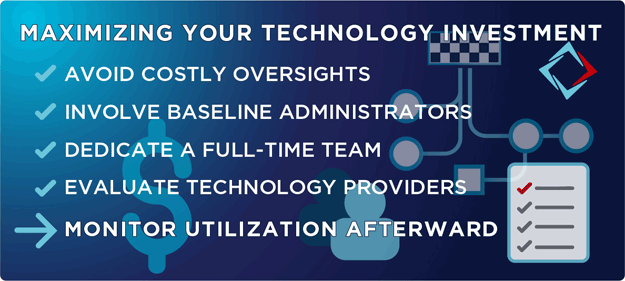
Equipment finance organizations are investing heavily in new technology for improved operations, profitability, efficiency and the transformation of their businesses. Despite recession fears, their investments will likely grow in the year ahead. Tech spending in North America and Europe across industries is forecast to rise by 13 percent in 2023, with 51 percent of companies planning to increase their information technology (IT) budgets, according to a Spiceworks Ziff Davis survey.
But many equipment finance businesses are skipping the final step necessary to ensure a strong return on technology investments. That step involves thorough follow-through to monitor actual utilization after going live. It’s critical to make sure the people who are supposed to be using the technology are doing so, as intended, and if not, resolve why.
A few weeks ago, my colleague Bryan Hunt, Chief Revenue Officer at LTi Technology Solutions, covered early oversights in the technology planning process that can cost companies down the road. His Equipment Finance Advisor article - "Critical First Step in Technology Investment is Often Missed" - stressed the importance of involving baseline administrators, dedicating a full-time team to the project when possible and carefully evaluating technology providers.
This article, however, focuses on the back end of technology implementations. The goal: encouraging equipment finance businesses to prevent costly oversights by monitoring utilization after going live.
Let’s look at the most common reasons for underutilization, and how businesses can work with their technology providers to identify and remedy utilization issues for maximum return.

Causes of Underutilization
Underutilization is usually the result of a combination of issues preventing acceptance of the new technology.
Causes can vary depending on the user and business, but one frequent culprit is incomplete training. If users are pointed to an instruction manual and told to “click here” or “do this” and not given adequate instruction, some will lack the confidence to continue engaging with the new system moving forward. They will instead revert back to comfortable old habits and processes. Lack of training can also hamper utilization when staff turnover moves employees into new positions, but they have not been instructed how to use the technology in their new capacity.
Even with ample training, though, underutilization can occur when users don’t feel the technology really benefits their own jobs or improves their overall user experience. A user needs to understand “the why” for entering certain data or doing a certain task and what the downstream impact of that is for the system and the organization. Without this level of understanding, there is the ever-present temptation to return to old, familiar processes.
So, lack of adequate training and understanding of the technology’s benefits are two key reasons for underutilization. The final reason we will explore – and a major problem across industries – is that many businesses aren’t aware of the need for thorough, systematic and ongoing follow-up with users after the technology goes live. The follow-through process not only uncovers and resolves underutilization issues related to training and employee understanding; it can also pinpoint other issues including cases where a user or department remains resistant to change regardless of a business’ best efforts.
Follow-through Is Key
We’ve talked about the value of follow-through after going live in addressing utilization issues, but what should that effort encompass? It should be a collaborative effort between a business and its technology provider. Specifics may vary but at LTi we can recommend some general parameters.
The designated system “owner” and/or project team for your business should schedule regular status check-ins with system users for 60 to 90 days after going live. These check-ins will help ensure employees are taking advantage of the system efficiencies that are designed and configured for their use – and are less tempted to fall back on old processes.
Your technology provider should also be in close touch for 60 to 90 days after the go-live date to provide continuity as your business settles into the new system. Through routine calls and contacts, your dedicated Account Manager can help you determine if systems and processes are working as expected, and key performance indicators (KPIs) established for the project are being met or exceeded. They can also discuss if there are any needs for additional training, education and/or software, and whether there are upcoming business initiatives requiring the technology provider’s help. One question your Account Manager will ask is whether your regular check-ins with users show employees understand the system, data and processes.
Six to nine months after the new technology goes live, a business and its technology provider should schedule another “check-in” to see how things are going and how the system is being utilized. This is a suitable time to tweak system configuration and fine-tune processes, if needed. It also provides opportunities for additional training.
Keep Monitoring
Monitoring utilization after going live is critical for realizing the full value of a company’s technology investment as it can uncover and correct issues that may be hampering productivity. For best results, utilization monitoring should begin immediately after going live, involve regular contacts with system users and the company’s technology provider for 60 to 90 days after, and include another major check-in during the six- to nine-month timeframe. From there, equipment finance companies are wise to continue periodic utilization monitoring and have a plan in place for training and educating new employees on the system.